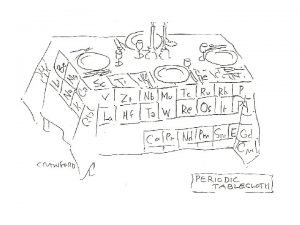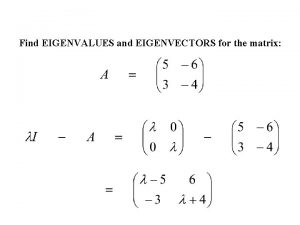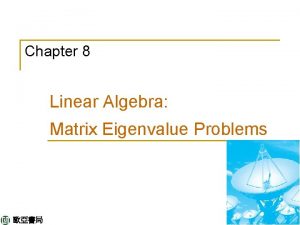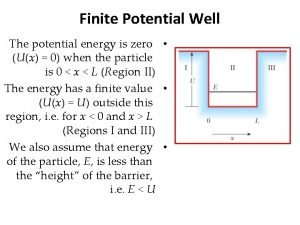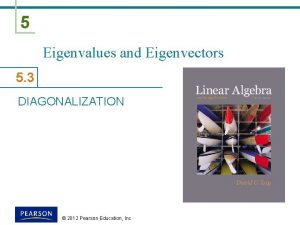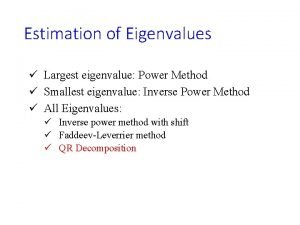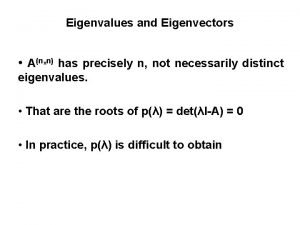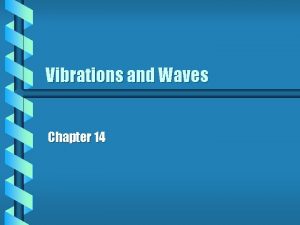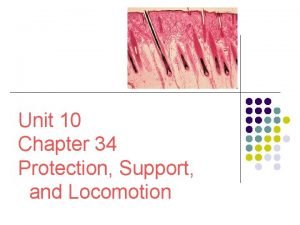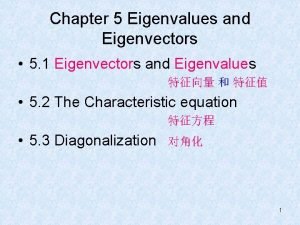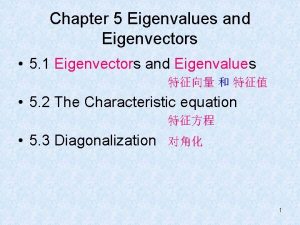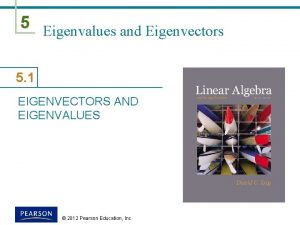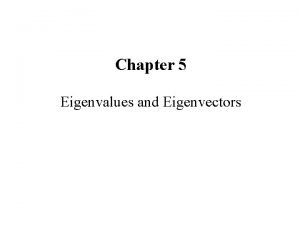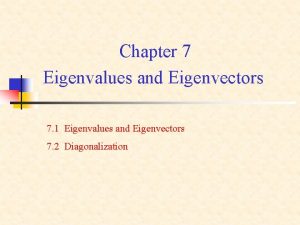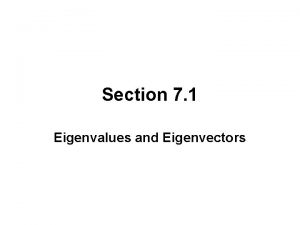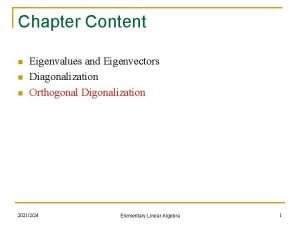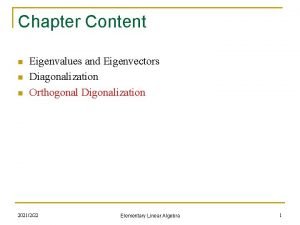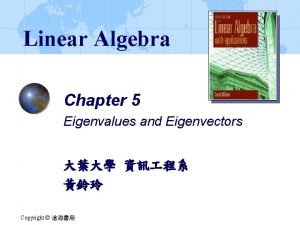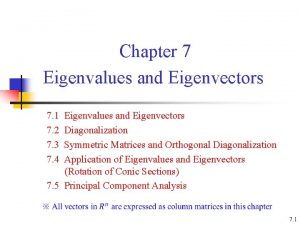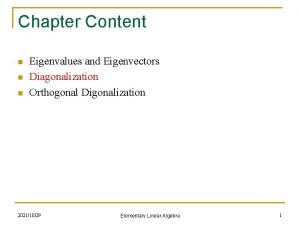Chapter 7 Eigenvalues and Eigenvectors 7 1 Eigenvalues















































































- Slides: 79

Chapter 7 Eigenvalues and Eigenvectors 7. 1 Eigenvalues and Eigenvectors 7. 2 Diagonalization 7. 3 Symmetric Matrices and Orthogonal Diagonalization 7. 4 Application of Eigenvalues and Eigenvectors 7. 5 Principal Component Analysis 7. 1

7. 1 Eigenvalues and Eigenvectors n Eigenvalue problem (特徵值問題) (one of the most important problems in the linear algebra): If A is an n n matrix, do there exist nonzero vectors x in Rn such that Ax is a scalar multiple of x? (The term eigenvalue is from the German word Eigenwert, meaning “proper value”) n Eigenvalue (特徵值) and Eigenvector (特徵向量): A: an n n matrix ※ Geometric Interpretation : a scalar (could be zero) x: a nonzero vector in Rn Eigenvalue Eigenvector 7. 2

n Ex 1: Verifying eigenvalues and eigenvectors Eigenvalue Eigenvector Eigenvalue ※ In fact, for each eigenvalue, it has infinitely many eigenvectors. For = 2, [3 0]T or [5 0]T are both corresponding eigenvectors. Moreover, ([3 0] + [5 0])T is still an eigenvector. The proof is in Thm. 7. 1. Eigenvector 7. 3

n Thm. 7. 1: The eigenspace corresponding to of matrix A If A is an n n matrix with an eigenvalue , then the set of all eigenvectors of together with the zero vector is a subspace of Rn. This subspace is called the eigenspace (特徵空間) of Pf: x 1 and x 2 are eigenvectors corresponding to Since this set is closed under vector addition and scalar multiplication, this set is a subspace of Rn according to Theorem 4. 5 7. 4

n Ex 3: Examples of eigenspaces on the xy-plane For the matrix A as follows, the corresponding eigenvalues are 1 = – 1 and 2 = 1: Sol: For the eigenvalue 1 = – 1, corresponding vectors are any vectors on the x-axis ※ Thus, the eigenspace corresponding to = – 1 is the xaxis, which is a subspace of R 2 For the eigenvalue 2 = 1, corresponding vectors are any vectors on the y-axis ※ Thus, the eigenspace corresponding to = 1 is the yaxis, which is a subspace of R 2 7. 5

※ Geometrically speaking, multiplying a vector (x, y) in R 2 by the matrix A corresponds to a reflection to the y-axis, i. e. , left multiplying A to v can transform v to another vector in the same vector space 7. 6

n Thm. 7. 2: Finding eigenvalues and eigenvectors of a matrix A Mn n Let A be an n n matrix. (1) An eigenvalue of A is a scalar such that (2) The eigenvectors of A corresponding to are the nonzero solutions of n Note: follwing the definition of the eigenvalue problem (homogeneous system) has nonzero solutions for x iff (The above iff results comes from the equivalent conditions on Slide 4. 101) n Characteristic equation (特徵方程式) of A: n Characteristic polynomial (特徵多項式) of A Mn n: 7. 7

n Ex 4: Finding eigenvalues and eigenvectors Sol: Characteristic equation: Eigenvalue: 7. 8

7. 9

n Ex 5: Finding eigenvalues and eigenvectors Find the eigenvalues and corresponding eigenvectors for the matrix A. What is the dimension of the eigenspace of each eigenvalue? Sol: Characteristic equation: Eigenvalue: 7. 10

The eigenspace of λ = 2: Thus, the dimension of its eigenspace is 2 7. 11

n Notes: (1) If an eigenvalue 1 occurs as a multiple root (k times) for the characteristic polynominal, then 1 has multiplicity ( 重數) k (2) The multiplicity of an eigenvalue is greater than or equal to the dimension of its eigenspace. (In Ex. 5, k is 3 and the dimension of its eigenspace is 2) 7. 12

n Ex 6:Find the eigenvalues of the matrix A and find a basis for each of the corresponding eigenspaces Sol: Characteristic equation: Eigenvalues: ※ According to the previous slide, the dimension of the eigenspace of λ 1 = 1 is at most to be 2 ※ For λ 2 = 2 and λ 3 = 3, the demensions of their eigenspaces are at most to be 1 7. 13

is a basis for the eigenspace corresponding to ※The dimension of the eigenspace of λ 1 = 1 is 2 7. 14

is a basis for the eigenspace corresponding to ※The dimension of the eigenspace of λ 2 = 2 is 1 7. 15

is a basis for the eigenspace corresponding to ※The dimension of the eigenspace of λ 3 = 3 is 1 7. 16

n n Thm. 7. 3: Eigenvalues for triangular matrices If A is an n n triangular matrix, then its eigenvalues are the entries on its main diagonal Ex 7: Finding eigenvalues for triangular and diagonal matrices Sol: ※According to Thm. 3. 2, the determinant of a triangular matrix is the product of the entries on the main diagonal 7. 17

n Eigenvalues and eigenvectors of linear transformations: ※ The definition of linear transformation functions should be introduced in Ch 6 ※ Here I briefly introduce the linear transformation and its some basic properties ※ The typical example of a linear transformation function is that each component of the resulting vector is the linear combination of the components in the input vector x n An example for a linear transformation T: R 3→R 3 7. 18

n Theorem: Standard matrix for a linear transformation 7. 19

n n Consider the same linear transformation T(x 1, x 2, x 3) = (x 1 + 3 x 2, 3 x 1 + x 2, – 2 x 3) Thus, the above linear transformation T is with the following corresponding standard matrix A such that T(x) = Ax ※ The statement on Slide 7. 18 is valid because for any linear transformation T: V →V, there is a corresponding square matrix such that T(x) = Ax. Consequently, the eignvalues and eigenvectors of a linear transformation T are in essence the eigenvalues and eigenvectors of the corresponding square matrix A 7. 20

n Ex 8: Finding eigenvalues and eigenvectors for standard matrices ※ A is the standard matrix for T(x 1, x 2, x 3) = (x 1 + 3 x 2, 3 x 1 + x 2, – 2 x 3) (see Slides 7. 19 and 7. 20) Sol: 7. 21

n Transformation matrix for nonstandard bases ※ On the next two slides, an example is provided to verify numerically that this extension is valid 7. 22

n EX. Consider an arbitrary nonstandard basis to be {v 1, v 2, v 3}= {(1, 1, 0), (1, – 1, 0), (0, 0, 1)}, and find the transformation matrix such that corresponding to the same linear transformation T(x 1, x 2, x 3) = (x 1 + 3 x 2, 3 x 1 + x 2, – 2 x 3) 7. 23

n Consider x = (5, – 1, 4), and check that corresponding to the linear transformation T(x 1, x 2, x 3) = (x 1 + 3 x 2, 3 x 1 + x 2, – 2 x 3) 7. 24

7. 25

Keywords in Section 7. 1: n eigenvalue problem: 特徵值問題 n eigenvalue: 特徵值 n eigenvector: 特徵向量 n characteristic equation: 特徵方程式 n characteristic polynomial: 特徵多項式 n eigenspace: 特徵空間 n multiplicity: 重數 n linear transformation: 線性轉換 n diagonalization: 對角化 7. 26

7. 2 Diagonalization n Diagonalization problem (對角化問題): For a square matrix A, does there exist an invertible matrix P such that P– 1 AP is diagonal? n Diagonalizable matrix (可對角化矩陣): Definition 1: A square matrix A is called diagonalizable if there exists an invertible matrix P such that P– 1 AP is a diagonal matrix (i. e. , P diagonalizes A) Definition 2: A square matrix A is called diagonalizable if A is similar to a diagonal matrix ※ In Sec. 6. 4, two square matrices A and B are similar if there exists an invertible matrix P such that B = P– 1 AP. n Notes: This section shows that the eigenvalue and eigenvector problem is closely related to the diagonalization problem 7. 27

n Thm. 7. 4: Similar matrices have the same eigenvalues If A and B are similar n n matrices, then they have the same eigenvalues Pf: For any diagonal matrix in the form of D = λI, P– 1 DP = D Consider the characteristic equation of B: Since A and B have the same characteristic equation, they are with the same eigenvalues ※ Note that the eigenvectors of A and B are not necessarily identical 7. 28

n Ex 1: Eigenvalue problems and diagonalization programs Sol: Characteristic equation: 7. 29

n Note: If ※ The above example can verify Thm. 7. 4 since the eigenvalues for both A and P– 1 AP are the same to be 4, – 2, and – 2 ※ The reason why the matrix P is constructed with the eigenvectors of A is demonstrated in Thm. 7. 5 on the next slide 7. 30

n Thm. 7. 5: Condition for diagonalization An n n matrix A is diagonalizable if and only if it has n linearly independent eigenvectors ※ If there are n linearly independent eigenvectors, it does not imply that there are n distinct eigenvalues. In an extreme case, it is possible to have only one eigenvalue with the multiplicity n, and there are n linearly independent eigenvectors for this eigenvalue Pf: ※ On the other hand, if there are n distinct eigenvalues, then there are n linearly independent eigenvectors (see Thm. 7. 6), and thus A must be diagonalizable 7. 31

7. 32


n Ex 4: A matrix that is not diagonalizable Sol: Characteristic equation: Since A does not have two linearly independent eigenvectors, A is not diagonalizable 7. 34

n Steps for diagonalizing an n n square matrix: Step 1: Find n linearly independent eigenvectors for A with corresponding eigenvalues Step 2: Let Step 3: 7. 35

n Ex 5: Diagonalizing a matrix Sol: Characteristic equation: 7. 36

7. 37

7. 38

n Note: a quick way to calculate Ak based on the diagonalization technique 7. 39

Thm. 7. 6: Sufficient conditions for diagonalization If an n n matrix A has n distinct eigenvalues, then the corresponding eigenvectors are linearly independent and thus A is diagonalizable according to Thm. 7. 5. Pf: Let λ 1, λ 2, …, λn be distinct eigenvalues and corresponding eigenvectors be x 1, x 2, …, xn. In addition, consider that the first m eigenvectors are linearly independent, but the first m+1 eigenvectors are linearly dependent, i. e. , n where ci’s are not all zero. Multiplying both sides of Eq. (1) by A yields 7. 40

On the other hand, multiplying both sides of Eq. (1) by λm+1 yields Now, subtracting Eq. (2) from Eq. (3) produces Since the first m eigenvectors are linearly independent, we can infer that all coefficients of this equation should be zero, i. e. , Because all the eigenvalues are distinct, it follows all ci’s equal to 0, which contradicts our assumption that xm+1 can be expressed as a linear combination of the first m eigenvectors. So, the set of n eigenvectors is linearly independent given n distinct eigenvalues, and according to Thm. 7. 5, we can conclude that A is diagonalizable 7. 41

n Ex 7: Determining whether a matrix is diagonalizable Sol: Because A is a triangular matrix, its eigenvalues are According to Thm. 7. 6, because these three values are distinct, A is diagonalizable 7. 42

n Ex 8: Finding a diagonalized matrix for a linear transformation Sol: The standard matrix for T is given by From Ex. 5 you know that λ 1 = 2, λ 2 = – 2, λ 3 = 3 and thus A is diagonalizable. So, similar to the result on Slide 7. 25, these three linearly independent eigenvectors found in Ex. 5 can be 7. 43 used to form the basis. That is

The matrix for T relative to this basis is ※ Note that it is not necessary to calculate through the above equation. According to the result on Slide 7. 25, we already know that is a diagonal matrix and its main diagonal entries are corresponding eigenvalues of A 7. 44

Keywords in Section 7. 2: n diagonalization problem: 對角化問題 n diagonalization: 對角化 n diagonalizable matrix: 可對角化矩陣 7. 45

7. 3 Symmetric Matrices and Orthogonal Diagonalization n Symmetric matrix (對稱矩陣): A square matrix A is symmetric if it is equal to its transpose: n Ex 1: Symmetric matrices and nonsymetric matrices (symmetric) (nonsymmetric) 7. 46

n Thm 7. 7: Eigenvalues of symmetric matrices If A is an n n “symmetric” matrix, then the following properties are true (1) A is diagonalizable (symmetric matrices (except the matrices in the form of A = a. I, in which case A is already diagonal) are guaranteed to have n linearly independent eigenvectors and thus be diagonalizable) (2) All eigenvalues of A are real numbers (3) If is an eigenvalue of A with the multiplicity to be k, then has k linearly independent eigenvectors. That is, the eigenspace of has dimension k ※ The above theorem is called the Real Spectral Theorem (實數頻譜理 論), and the set of eigenvalues of A is called the spectrum (頻譜) of A 7. 47

n Ex 2: Prove that a 2 × 2 symmetric matrix is diagonalizable Pf: Characteristic equation: As a function in , this quadratic polynomial function has a nonnegative discriminant (判別式) as follows 7. 48

※ Note that in this case, A has one eigenvalue, a, whose multiplicity is 2, and the two eigenvectors are linearly independent The characteristic polynomial of A has two distinct real roots, which implies that A has two distinct real eigenvalues. According to Thm. 7. 6, A is diagonalizable 7. 49

n n Orthogonal matrix (正交矩陣): A square matrix P is called orthogonal if it is invertible and Thm. 7. 8: Properties of orthogonal matrices An n n matrix P is orthogonal if and only if its column vectors form an orthonormal set Pf: Suppose the column vectors of P form an orthonormal set, i. e. , It implies that P– 1 = PT and thus P is orthogonal 7. 50

n Ex 5: Show that P is an orthogonal matrix. Sol: If P is a orthogonal matrix, then 7. 51

7. 52

Thm. 7. 9: Properties of symmetric matrices Let A be an n n “symmetric” matrix. If 1 and 2 are distinct eigenvalues of A, then their corresponding eigenvectors x 1 and x 2 are orthogonal. (Thm. 7. 6 states that for “any” matrix, eigenvectors corresponding to distinct eigenvalues are linearly independent) Pf: n ※ For distinct eigenvalues of a symmetric matrix, their corresponding eigenvectors are orthogonal and thus linearly independent to each other (Theorem 5. 10 states that orthogonality implies linear independence) ※ Note that there may be multiple x 1’s and x 2’s corresponding to 1 and 2 7. 53

n n Orthogonal diagonalization (正交對角化): A matrix A is orthogonally diagonalizable if there exists an orthogonal matrix P such that P– 1 AP = D is diagonal Thm. 7. 10: Fundamental theorem of symmetric matrices An n n matrix A is orthogonally diagonalizable and has real eigenvalues if and only if A is symmetric Pf: See the next two slides 7. 54

n Orthogonal diagonalization of a symmetric matrix: Let A be an n n symmetric matrix. (1) Find all eigenvalues of A and determine the multiplicity of each ※ According to Thm. 7. 9, eigenvectors corresponding to distinct eigenvalues are orthognoal (2) For each eigenvalue of multiplicity 1, choose the unit eigenvector (3) For each eigenvalue of the multiplicity to be k 2, find a set of k linearly independent eigenvectors. If this set {v 1, v 2, …, vk} is not orthonormal, apply the Gram-Schmidt orthonormalization process 7. 55

(4) The composite of steps (2) and (3) produces an orthonormal set of n eigenvectors. Use these orthonormal and thus linearly independent eigenvectors as column vectors to form the matrix P. i. According to Thm. 7. 8, the matrix P is orthogonal ii. Following the diagonalization process on Slide 7. 35, D = P– 1 AP is diagonal Therefore, the matrix A is orthogonally diagonalizable 7. 56

n Ex 7: Determining whether a matrix is orthogonally diagonalizable Symmetric matrix Orthogonally diagonalizable 7. 57

n Ex 9: Orthogonal diagonalization Sol: ※ Verify Thm. 7. 9 that v 1·v 2 = v 1·v 3 = 0 orthogonal 7. 58

※If v 2 and v 3 are not orthogonal, the Gram-Schmidt Process should be performed. Here we simply normalize v 2 and v 3 to find the corresponding unit vectors ※ Note that there are some calculation error in the solution of Ex. 9 in the text book 7. 59

Summary of Sections 7. 2 and 7. 3: n 7. 60

Keywords in Section 7. 3: n symmetric matrix: 對稱矩陣 n orthogonal matrix: 正交矩陣 n orthonormal set: 單範正交集 n orthogonal diagonalization: 正交對角化 7. 61

7. 4 Applications of Eigenvalues and Eigenvectors n The rotation for quadratic equation: ax 2 + bxy + cy 2 + dx + ey + f = 0 n Ex 5: Identify the graphs of the following quadratic equations Sol: ※ Since there is no xy-term, it is easy to derive the standard form and it is apparent that this equation represents an ellipse. 7. 62

※ Since there is a xy-term, it is difficult to identify the graph of this equation. In fact, it is also an ellipse, which is oblique on the xy-plane. ※ There is a easy way to identify the graph of quadratic equation. The basic idea is to rotate the x- and y-axes to x’- and y’-axes such that there is no more x’y’-term in the new quadratic equation. ※ In the above example, if we rotate the x- and yaxes by 45 degree counterclockwise, the new quadratic equation can be derived, which represents an ellipse apparently. ※ In Section 4. 8, the rotation of conics is achieved by changing basis, but here the diagonalization technique based on eigenvalues and eignvectors is applied to solving the rotation problem 7. 63

n Quadratic form (二次形式): ax 2 + bxy + cy 2 is the quadratic form associated with the quadratic equation ax 2 + bxy + cy 2 + dx + ey + f = 0 n Matrix of the quadratic form: ※ Note that A is a symmetric matrix If we define X = , then XTAX= ax 2 + bxy + cy 2. In fact, the quadratic equation can be expressed in terms of X as follows 7. 64

n Principal Axes Theorem (主軸定理) For a conic whose equation is ax 2 + bxy + cy 2 + dx + ey + f = 0, the rotation to eliminate the xy-term is achieved by X = PX’, where P is an orthogonal matrix that diagonalizes A. That is, where λ 1 and λ 2 are eigenvalues of A. The equation for the rotated conic is given by 7. 65

Pf: According to Thm. 7. 10, since A is symmetric, we can conclude that there exists an orthogonal matrix P such that P – 1 AP = PTAP = D is diagonal Replacing X with PX’, the quadratic form becomes ※ It is obvious that the new quadratic form in terms of X’ has no x’y’-term, and the coefficients for (x’)2 and (y’)2 are the two eigenvalues of the matrix A ※ 7. 66

n Ex 6: Rotation of a conic Perform a rotation of axes to eliminate the xy-term in the following quadratic equation Sol: The matrix of the quadratic form associated with this equation is The eigenvalues are λ 1 = 8 and λ 2 = 18, and the corresponding eigenvectors are 7. 67

After normalizing each eigenvector, we can obtain the orthogonal matrix P as follows. ※ According to the results on p. 268 in Ch 4, X=PX’ is equivalent to rotate the xycoordinates by 45 degree to form the new x’y’-coordinates, which is also illustrated in the figure on Slide 7. 62 Then by replacing X with PX’, the equation of the rotated conic is which can be written in the standard form ※ The above equation represents an ellipse on the x’y’-plane 7. 68

n In three-dimensional version: ax 2 + by 2 + cz 2 + dxy + exz + fyz is the quadratic form associated with the equation of quadric surface: ax 2 + by 2 + cz 2 + dxy + exz + fyz + gx + hy + iz + j = 0 n Matrix of the quadratic form: ※ Note that A is a symmetric matrix If we define X = [x y z]T, then XTAX= ax 2 + by 2 + cz 2 + dxy + exz + fyz, and the quadratic surface equation can be expressed as 7. 69

Keywords in Section 7. 4: n quadratic form (二次形式) n principal axes theorem (主軸定理) 7. 70

7. 5 Principal Component Analysis (主成分分析) n Principal component analysis It is a way of identifying the underlying patterns in data l It can extract information in a large data set with many variables and approximate this data set with fewer factors l In other words, it can reduce the number of variables to a more manageable set l n Steps of the principal component analysis Step 1: Get some data l Step 2: Subtract the mean l Step 3: Calculate the covariance matrix l Step 4: Calculate the eigenvectors and eigenvalues of the covariance matrix l Step 5: Deriving the transformed data set l Step 6: Getting the original data back l 7. 71

Step 1: x* Step 2: y* 2. 5 0. 5 2. 2 1. 9 3. 1 2. 3 2. 0 1. 5 1. 1 1. 81 x 2. 4 0. 7 2. 9 2. 2 3. 0 2. 7 1. 6 1. 1 1. 6 0. 9 1. 91 y 0. 69 -1. 31 0. 39 0. 09 1. 29 0. 49 0. 19 -0. 81 -0. 31 -0. 71 0 0. 49 -1. 21 0. 99 0. 29 1. 09 0. 79 -0. 31 -0. 81 -0. 31 -1. 01 0 Step 3: 7. 72

l Step 4: Calculate the eigenvectors and eigenvalues of the covariance matrix A 7. 73

※ The intuition behind the principal component analysis: (It also implies that the new series of x’ and y’ are independent) 7. 74

l Step 5: Deriving the transformed data set: x’ y’ x’ -0. 82797 1. 77758 -0. 99220 -0. 27421 -1. 67580 -0. 91295 0. 09911 1. 14457 0. 43805 1. 22382 0 -0. 17512 0. 14286 0. 38437 0. 13042 -0. 20950 0. 17528 -0. 34982 0. 04642 0. 01776 -0. 16268 0 -0. 82797 1. 77758 -0. 99220 -0. 27421 -1. 67580 -0. 91295 0. 09911 1. 14457 0. 43805 1. 22382 0 y’ 0 0 0 7. 75

l Step 6: Getting the original data back: case 1 x* case 2 x* y* 2. 5 0. 5 2. 2 1. 9 3. 1 2. 3 2 1 1. 5 1. 1 1. 81 2. 4 0. 7 2. 9 2. 2 3 2. 7 1. 6 1. 1 1. 6 0. 9 1. 91 ※ We can derive the original data set if we take both v 1 and v 2 and thus x’ and y’ into account when deriving the transformed data y* 2. 37 0. 61 2. 48 2. 00 2. 95 2. 43 1. 74 1. 03 1. 51 0. 98 1. 81 2. 52 0. 60 2. 64 2. 11 3. 14 2. 58 1. 84 1. 07 1. 59 1. 01 1. 91 ※ Although when we derive the transformed data, only v 1 and thus only x’ are considered, the data gotten back is still similar to the original data. That means, x’ can be a common factor almost able to explain both series x and y 7. 76

※ If only the principal component x’ is considered in the Principal Component Analysis, it is equivalent to project all points onto the v 1 vector ※ It can be observed in the above figure that the projection onto v 1 vector can retains as much as possible the interpoint distance information (variance) that was contained in the original series of (x, y) 7. 77

l l Factor loadings: the correlations between the principal components (F 1 = x’ and F 2 = y’) and the original variables (x 1 = x and x 2 = y) (Note that x and y should be expressed as the linear combination of x’ and y’ for deriving factor loadings) Factor loadings are used to identify and interpret the unobservable principal components ※ The factor loadings of x’ on x and y are close to 1 in absolute levels, which implies the principal component x’ can explain x and y quite well and thus x’ can viewed as an index to represent the combined information of x and y 7. 78

※ Questionnaire (問卷) analysis: salary vs. personality and learned-courses information i. If there are five variables (the results of five problems), x 1 to x 5, x 1 to x 3 are about personality information of the respondent (作答者), and x 4 and x 5 are about the course information which this respondent had learned ii. Suppose there are two more important principal components x 1’ and x 2’ (x 3’ , x 4’ , and x 5’ are less important principal components), and the principal component x 1’ is highly correlated with x 1 to x 3 and the principal component x 2’ is highly correlated with x 4 and x 5 iii. x 1’ can be interpreted as a general index to represent the personal characteristic, and x 2’ can be interpreted as a general index associated with the course profile that the respondent had learned iv. Study the relationship between the salary level and the personalcharacteristic index x 1’ and education index x 2’ 7. 79
 What is a unit eigenvector
What is a unit eigenvector Eigenvalues and eigenvectors
Eigenvalues and eigenvectors Eigenspace
Eigenspace Eigen values properties
Eigen values properties Eigendecomposition
Eigendecomposition Principal axis transformation
Principal axis transformation Linear algebra for dummies
Linear algebra for dummies Eigenvectors
Eigenvectors Unitary matrix
Unitary matrix Infinite potential barrier
Infinite potential barrier Eigenvalues properties
Eigenvalues properties Eigenvector
Eigenvector Diagonalize matrix
Diagonalize matrix Eigenvector
Eigenvector Twitter.com
Twitter.com Kshum
Kshum Eigenvalues
Eigenvalues Eigenvalues
Eigenvalues Eigenvalues
Eigenvalues 7 ionic and metallic bonding
7 ionic and metallic bonding Chapter 7 ionic and metallic bonding chapter answer key
Chapter 7 ionic and metallic bonding chapter answer key Chapter 7 chapter assessment ionic compounds and metals
Chapter 7 chapter assessment ionic compounds and metals Chemistry chapter 7 ionic and metallic bonding
Chemistry chapter 7 ionic and metallic bonding Chapter 9 chemical names and formulas
Chapter 9 chemical names and formulas Red tent summary
Red tent summary Great gatsby chapter 8 and 9 summary
Great gatsby chapter 8 and 9 summary Chapter 10 chemical reactions answer key
Chapter 10 chemical reactions answer key Chapter 11 study guide stoichiometry
Chapter 11 study guide stoichiometry Chapter 9 study guide chemical reactions
Chapter 9 study guide chemical reactions Chapter 7 similarity chapter test form a answer key
Chapter 7 similarity chapter test form a answer key Chapter 6: career readiness
Chapter 6: career readiness Chapter 9 surface water answer key
Chapter 9 surface water answer key Chapter 2 physics test prep representing motion
Chapter 2 physics test prep representing motion Chemistry the central science 14th edition
Chemistry the central science 14th edition Section 1 population dynamics answer key
Section 1 population dynamics answer key Chapter 2 standardized test practice answers
Chapter 2 standardized test practice answers Facts about the philippian jailer
Facts about the philippian jailer Describe 2 incidents involving automobiles in this chapter
Describe 2 incidents involving automobiles in this chapter The giver chapter 3 quiz
The giver chapter 3 quiz Chapter 5 diversity and human needs and development
Chapter 5 diversity and human needs and development Reinforcement theory of motivation
Reinforcement theory of motivation Bridge to terabithia chapter 7 questions and answers
Bridge to terabithia chapter 7 questions and answers Chapter 3 animal farm summary
Chapter 3 animal farm summary Chapter 24 the immune and lymphatic systems and cancer
Chapter 24 the immune and lymphatic systems and cancer The mouse and the motorcycle chapter 1 questions
The mouse and the motorcycle chapter 1 questions Section 4 review physical science
Section 4 review physical science Is the individual internal process that energizes directs
Is the individual internal process that energizes directs Lymph diagram
Lymph diagram Green orange purple
Green orange purple World war 1 and the russian revolution chapter 27
World war 1 and the russian revolution chapter 27 Chapter 10 section 2 central america and the caribbean
Chapter 10 section 2 central america and the caribbean Chapter 7 work design and measurement
Chapter 7 work design and measurement Chapter 14 section 1 work and power
Chapter 14 section 1 work and power Glue
Glue Why study financial markets?
Why study financial markets? Chapter 20 weather patterns and severe storms
Chapter 20 weather patterns and severe storms Chapter 17 mechanical waves and sound wordwise answer key
Chapter 17 mechanical waves and sound wordwise answer key How to fix forks in waves
How to fix forks in waves Walk two moons chapter 4
Walk two moons chapter 4 The visual and artistic aspects of presenting a product
The visual and artistic aspects of presenting a product Chapter 14 vibrations and waves
Chapter 14 vibrations and waves What is amphibia
What is amphibia Segment fg is the angle bisector of efh
Segment fg is the angle bisector of efh Chapter 28 human systems and homeostasis
Chapter 28 human systems and homeostasis Chapter 9 motion and energy answer key
Chapter 9 motion and energy answer key 5 determinants of supply
5 determinants of supply Chapter 3 lesson 3 expressing emotions in healthful ways
Chapter 3 lesson 3 expressing emotions in healthful ways Chapter 14:1 measuring and recording vital signs
Chapter 14:1 measuring and recording vital signs Chapter 37 respiration circulation and excretion
Chapter 37 respiration circulation and excretion Protection support and locomotion answer key
Protection support and locomotion answer key Crash costs are measured in dollars and in
Crash costs are measured in dollars and in Turmoil and change in mexico
Turmoil and change in mexico Tsotsi chapter 6 questions and answers
Tsotsi chapter 6 questions and answers Touching spirit bear study guide
Touching spirit bear study guide Touching spirit bear chapter 10 summary
Touching spirit bear chapter 10 summary Touching spirit bear chapter 20 questions and answers
Touching spirit bear chapter 20 questions and answers Chapter 2 tools and measuring instruments
Chapter 2 tools and measuring instruments Summary to kill a mockingbird chapter 12
Summary to kill a mockingbird chapter 12 Things fall apart chapter 4
Things fall apart chapter 4 Things fall apart chapter 18-19 summary
Things fall apart chapter 18-19 summary





